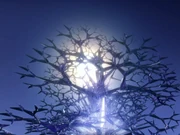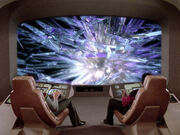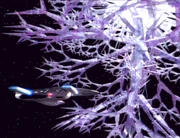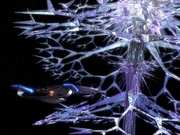
The Crystalline Entity above Melona IV
A Crystalline Entity (also called a Crystal Entity) was a powerful, spaceborne lifeform that resembled a large snowflake. It could travel at warp speeds and had the ability to consume all life on a planet or starship.
The first Crystalline Entity encountered by the Federation was responsible for thousands of deaths in the 24th century, until it was destroyed by the USS Enterprise-D in 2368. (TNG: "Datalore", "Silicon Avatar") By 2381, more Crystalline Entities were known to Starfleet. (LD: "I, Excretus")
Biology[]
The Entity functioned as a giant electromagnetic collector and needed constant power, converting organic matter into energy. Once the Entity ravaged a planet, the planet's natural resources were completely stripped. No further life would be able to grow for many years. Everything, including vegetation and bacteria, was completely converted. Bitrious matter was usually deposited in the Entity's wake, as were elevated levels of hydrocarbons, lanthanides, and nitrates. The Entity was unable to penetrate rock lined with both kelbonite and fistrium. Both metals needed to be present in order to refract the Entity's absorption power. The shields of a Galaxy-class starship were also impervious to the Entity. (TNG: "Datalore", "Silicon Avatar", "Inheritance")
History[]

Encountering the USS Enterprise-D
The Entity attacked the Omicron Theta colony in 2338, stripping all living material and killing many inhabitants, including Raymond Marr, Kila Marr's son. Colony residents Drs. Noonien and Juliana Soong both fled during the attack aboard an escape pod, although Juliana Soong was severely injured. (TNG: "Datalore", "Brothers", "Silicon Avatar", "Inheritance") The android Lore was an ally of the Entity and responsible for luring it to Omicron Theta.
In 2364, Lore was revived and promptly tried to "feed" the crew of the USS Enterprise-D to the Entity. The Enterprise's shields were enough to protect it from the Entity, and Lore was eventually transported into space. The Crystalline Entity retreated to parts unknown. (TNG: "Datalore")
Doctor Kila Marr, who had lost her son at Omicron Theta, became one of the Federation's foremost experts on the Crystalline Entity. She studied twelve attack sites, including Forlat III.

The Crystalline Entity feeding
In 2368, the Crystalline Entity destroyed the fledgling Federation colony on Melona IV. Two colonists, including Carmen Davila, were lost in the attack. Most of the colonists survived, thanks to a cavern lined with kelbonite and fistrium. The Enterprise rescued the survivors and brought Dr. Marr to the planet so she could further study the attack. She worked with Lieutenant Commander Data in order to develop a technique to communicate with the creature.
The Enterprise intercepted the Entity after it had killed the entire crew of a freighter, the Kallisko. They attracted the Entity by emitting graviton pulses at ten per second from the Enterprise, as lower pulse rates had no effect on the creature. The creature approached the Enterprise, replying with a series of graviton pulses that the Enterprise crew interpreted as meaningful, but which it needed time to decode. Marr increased the pulse rate, eventually trying a continuous graviton emission. The Entity stopped emitting pulses of its own as the emissions drove it into resonance. The Enterprise crew tried to stop the emissions, only to find that Marr had isolated the access code for the emission controls. Before the crew could halt the emissions, the resonance shattered the Entity. (TNG: "Silicon Avatar")
This required form of communication appears to contradict "Datalore", in which Lore was able to communicate with the entity via subspace.
In 2381, one of the simulator holopods provided by Shari yn Yem contained the program The Crystalline Entity. However, Yem had never served on a starship herself, and as a result vastly underestimated both the danger an Entity posed and a typical Starfleet crew's ability to handle such a frightening encounter. When Captain Carol Freeman and Ensign Beckett Mariner discovered that Yem had rigged all the holopods provided to the USS Cerritos and realized she had no practical experience with starship emergencies, they decided to approach a Crystalline Entity in order to frighten her. Searching for Crystalline Entities, Mariner remarked that it "must [have been] Crystalline Entity season or something" given the number of Entities detected, and Freeman ultimately settled on one that was feeding on unstable nebula radiation. The Cerritos was briefly caught in an electromagnetic resonance belt after investigating transphasic energy, but easily escaped, albeit with a deliberate delay in order to further agitate an already panicked Yem, using a graviton pulse. (LD: "I, Excretus")
Appendices[]
Appearances[]
- TNG:
- "Datalore" (Season 1)
- "Silicon Avatar" (Season 5)
- LD:
- "I, Excretus" (Season 2)
- Opening credits (Season 3)
- Opening credits (Season 4)
Background information[]
Described in the script of the episode "Datalore" as, "MOVING IN to float close to our starship, the SHIMMERING CRYSTAL COMPLEXITY is very obvious. It looks both very lovely and terribly powerful at the same time.(...) The huge crystal form, two or three times the size of the starship, SLOWLY SPINNING, pictorially dominating the starship as it floats next to it (scenes 55a & 56), the entity was eventually visually conceptualized by Andrew Probert in October 1988 (The Art of Star Trek, pp. 64-65), though he has stated that while model makers usually closely followed his designs, he considered the Crystalline Entity the only exception to this rule, as the final product differed radically from his concept drawings. (Star Trek: The Magazine Volume 2, Issue 12, p. 45)
In its very first appearance, the Crystalline Entity was one of the very first CGI sequences used in the Star Trek franchise. It was built and rendered by Chris Alsop at The Post Group (Star Trek: Communicator issue 148, p. 49). Conceived and constructed well before the breakthrough of the technique, CGI was in 1987 a very costly, and, even more importantly as far as a week-by-week television production was concerned, a very time consuming proposition, as Visual Effects Coordinator Ronald B. Moore has dryly observed, "This was very early in the development of CG to be doing something like this for television but we were game. It took a long time to build the model and it was extremely costly. When the show was finished and we were watching the final results I remember Rob [Legato] commenting that we could have painted a tumbleweed white and shot that. It would have cost less and we would have been done much sooner. I think he was right: it might have worked just as well." (Flying Starships, p. 41) The very first full-textured CGI effect in Star Trek was the Genesis file in Star Trek II: The Wrath of Khan.

|

|
On 11 April 2012, director Robert Meyer Burnett confirmed and released the first image of the, in high definition, remastered Crystalline Entity for the Blu-ray Disc edition of TNG Season 1. [1] However, as the original CGI files of the entity were lost, the model was recreated with the use of the latest CGI techniques at CBS Digital [2] in the LightWave 3D software, as was confirmed by Michael Okuda, "Yes, the original Crystalline Entity was created on a computer system that probably no longer exists. CBS Digital's Niel Wray rebuilt it from scratch, retaining the original design, but making it more beautiful than ever." [3] Visual Effects Coordinator Sarah Paul elaborated, "There was no film element for it and Max went, "Oh yeah, that was originally created in 3D.", which we did not have the 3D files for. When we don't have an element like the crystalline, we hand it off to Niel, and they will literally remodel and do the entire shot over." Wray added,
"The crystalline entity, I'm pretty proud of. The 3D team did an amazing job. You look at the original and it just looks kind of flat and dated. I think of the time period, and I'm blown away that they were able to do something like that to that level way back then. We don't want to go through this and try to re-imagine it or create something totally new. So what we were trying to do, was to get as close as possible to the original visual effects shot. We spent like a week recreating that model. I mean, there is nothing that exists, so we had to do it all by eye. The level of complexity is pretty amazing. With HD resolution you're having so much more detail, so we had to kinda bring up the quality level a little bit, but we tried to leave it as close to the original as possible." (TNG Season 1 Blu-ray-special feature, "Energized! Taking The Next Generation to the Next Level")
Apocrypha[]
In the non-canon novel Orion's Hounds, the USS Titan encountered a number of these creatures, along with the entities seen in "Encounter at Farpoint" and other spaceborne lifeforms. These beings were given the collective term "cosmozoans", a term later used canonically in "That Hope Is You, Part 2" for the gormagander.
Another, more powerful, Crystalline Entity appears in Star Trek Online. The Tholians seem to worship and protect it.
The Crystalline Entity makes an appearance in the 1999 PC game Star Trek: The Next Generation - Birth of the Federation, although it's called the Crystal Entity.
The Crystalline Entity also appears in "Guardians", a short story in Strange New Worlds VII, as one of several parties who attempt to seize the Guardian of Forever, only to be driven off by the Horta.
External link[]
- Crystalline Entity at Memory Beta, the wiki for licensed Star Trek works

